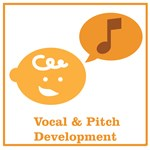|

Lesson #2

It’s so fun to see all of you playing with your little ones in class!
Please remember to LISTEN to the music and PLAY with your children at home – in class I teach you fun ways to play at home! Young children need to hear these songs about 100 times - keep it PLAYing!
I would like to know who is reading this newsletter. Please text to let me know what your child's favorite activity is so far!
Next class we'll sing these songs:
- Name, Name, What's Your Name?
- A, You're Adorable
- Over the Deep Blue Sea
- Five Little Sandcastles
- Bickle Bockle
- In My Class I Have Some Bells
- Charlie Over the Ocean
- Lukey's Boat
- Aquarium
- Pearly Shells

Children’s ears begin forming in the womb. As fetuses, they are capable of identifying their native (most spoken) language, tones, vowel sounds, and syllables. As newborns, they can segregate and recognize tones, detect beats, and recognize and process sounds. Their ears and voices continue to grow throughout their life, but the greatest growth occurs during the formative years between 0-8 (we call this the music window and is the reason for Sound Beginnings/Let’s Play Music!). If you’d like more information, listen to our LPM podcast: Music in Utero with Dr. Krystal McCoy.
Call and response songs (like Charlie Over the Ocean) allow children to imitate short patterns and song fragments which helps them learn to sing with accurate pitch.
Besides being fun to use, dancing scarves promote self expression, full body movement, coordination, and imagination in young children.
Optional home fun activity: Color your bells on page 7 of your workbook. You can hold a paper on each side of the bell if you'd like to help them to color in the lines. (Remember, these activities are optional but can be a great bonding experience to do with your child during the week.)
Did you know that you have tone bells on your LPM app? Just click the note icon in the bottom left corner. Be sure your volume is up and your phone isn't set to "Silent Mode" (if you have an iPhone). Try it on a tablet if you have one!
Please let me know if you have any questions about accessing this awesome feature!
 |
Sound Beginnings is education through musical play! It prepares children for success in Kindergarten and Let’s Play Music. Sound beginnings provides research-based elements that stimulate growth in the areas particularly crucial to the development of the young child. These elements make up the foundation of the Sound Beginnings curriculum. Here is just one:
|
 |
Sound Beginnings channels the young voice into beautiful, in-tune singing by providing proper vocal modeling in the correct range. Solfege hand signs teach pitch relationships; the minor 3rd (SOL-MI) pattern is used to develop in-tune singing and pitch matching.
|
|
